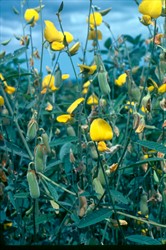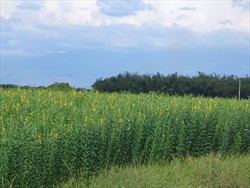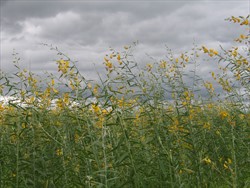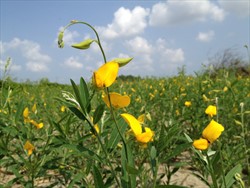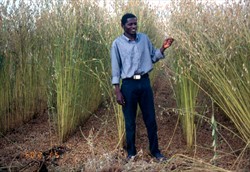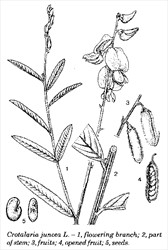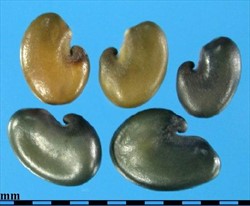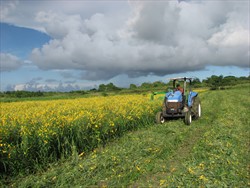Crotalaria juncea
Tropical Forages
GRIN: None listed
ILDIS: Crotalaria benghalensis Lam.; Crotalaria fenestrata Sims; Crotalaria ferestrata Sims; Crotalaria porrecta Wall.; Crotalaria sericea Willd.; Crotalaria tenuifolia Roxb.; Crotalaria viminea Wall.
Family: Fabaceae (alt. Leguminosae) subfamily: Faboideae tribe: Crotalarieae.
An erect annual, up to 3.5 m tall. Laxly branched, depending on plant density (there may be a single stem in dense stands). Vigorous lateral roots and long taproot that can exploit deeply stored soil moisture. Stem ridged and pubescent, up to 2 cm in diameter. Leaves are simple; oblong-elliptical, 4‒13 × 0.5‒3 cm; sparsely appressed-pubescent above, more densely so below; petiole 2–3(-5) mm long; stipules 2–3 mm long, caducous. Inflorescence a terminal open raceme, up to 25 cm long, with 18‒20 bright yellow flowers, showy; sepals 5, hairy; standard erect, suborbicular, ca. 2.5 cm in diameter. Pod cylindrical, 3‒6 × 1‒2 cm, tomentose, light brown, containing ca. 6 seeds. Seeds heart- to kidney-shaped, with narrow end strongly incurved, up to 6 mm long, dark brown to black; loose when mature and rattling in the pod. About 33,000 seeds/kg.
Asia: kâk'tung (Cambodia); 菽麻 shu ma (China); san, sunn (India); orok-orok lembut (Indonesia); po:th'üang, thwax chu:b (Laos); putok-putukan (Tagalog), karay-kagay (Bikol) (Philippines); po-thuang (Thailand); suc sat, lue lac (Vietnam)
English: sunn hemp, sunn crotalaria, sann-hemp brown hemp, Indian hemp, Madras hemp
Europe: chanvre du Bengale, chanvre indien, crotolaire jonciforme (French); Sanhanf (German); sunnhampa (Swedish)
Latin America: cânhamo-da-Índia, crotalária (Brazil); cáñamo san, matraca, sonajuelas (Spanish)
Native:
Asia: Bangladesh; Bhutan; India
Cultivated/naturalized:
Throughout the subtropics and tropics
Forage
Leaves stripped to feed to livestock (e.g. as supplement to low-quality feedstuff).
Environment
Soil improvement when used as green manure (including to suppress nematodes).
Other
Mainly used as a source of fibre (extracted from the bark).
Soil requirements
Adapted to poor soils but responds to fertilization; pH 5‒7.5; intolerant of salt and prolonged water-logging. On light, well-drained soils production is higher than on clay soils.
Moisture
Drought tolerant, adapted to hot, semi-arid and arid areas.
Temperature
Being a short-lived warm-season plant, suitable for a wide range of climates as long as there is a hot summer; can tolerate light frosts.
Light
No shade tolerance reported.
Reproductive development
Sunn hemp is a short-day plant; long day-lengths favour vegetative growth, although daylength neutral selections exist. Fast growing; under favourable conditions reaching a plant height of 1.2 m in 60 days, 1.8 m in 90 days.
Defoliation
For green manure or forage, should be used at vegetative growth stage or at the beginning of flowering. Optimum cutting height to enable high yields and subsequent cuts should be about 30 cm.
Fire
No information available.
Guidelines for establishment and management of sown forages.
Establishment
High seed germination; 40‒50 kg seed/ha when used for green manure or forage; 100‒240 kg/ha when intended use is fibre production; 1‒2 cm sowing depth. Nodulates readily with native cowpea type rhizobia. 150‒165 kg/ha nitrogen contribution have been measured in 60 days.
Fertilizer
Responsive to P, K and Ca.
Compatibility (with other species)
Smothers weeds because of fast initial growth.
Companion species
Except for intercropping (with e.g. rice, wheat, Cenchrus americanus), C. juncea is generally not grown with other species.
Pests and diseases
Many pests and diseases are reported with varying degree of economic damage. To avoid build-up of disease and insect pressure, rotations are recommended.
Ability to spread
Although the pods are dehiscent, there is no indication of C. juncea being dispersed, to a major extent, by seed.
Weed potential
Nutritive value
18‒22% CP content in hay has been reported. 0.29% P; 1.40% Ca; 60% digestibility.
Palatability/acceptability
Animals are reported not to eat C. juncea when it is green; forage should be dried. Restriction recommendations in terms of hay to be offered to cattle vary between 10 and 45% of the animals' diet.
Toxicity
As other species of the genus Crotalaria, it contains poisonous glucosides (pyrrolizidine alkaloids).
Feedipedia link
Dry matter
Establishment yields 2 t DM/ha after 6‒8 weeks; thereafter, 3 further cuts at 4-week intervals may be possible.
Animal production
No data available.
2n = 16. Self-incompatible; extensive cross-pollination.
Up to 1.8 t/ha have been reported.
Fluchloralin and pendimethalin have shown to be effective for controlling early weed growth.
- Fast growth.
- Tolerance of low soil fertility.
- Tolerance of drought.
- Fairly high protein content.
- Forage potential restricted by concentrations of toxic glucosides.
Chee, Y.K. and Chen, C.P. (1992) Crotalaria juncea L. In: Mannetje, L.’t and Jones, R.M. (eds) Plant Resources of South-East Asia No. 4. Forages. Pudoc Scientific Publishers, Wageningen, the Netherlands. p. 98–100. edepot.wur.nl/327785
Rotar, P.P. and Joy, R.J. (1983) 'Tropic Sun' sun hemp; Crotalaria juncea L. Research Extension Series 36. University of Hawaii, Honolulu, USA. hdl.handle.net/10125/15089
Sarkar, S.K., Hazra, S.K., Sen, H.S., Karmakar, P.G. and Tripathi, M.K. 2015. Sunnhemp in India. Central Research Institute for Jute and Allied Fibres (ICAR), Barrackpore, West Bengal, India.
Wang, Q., Li, Y., Klassen, W. and Hanlon, E.A. Jr. (2018) Sunn Hemp ‒ A Promising Cover Crop in Florida. UF-IFAS Extension SL-306. University of Florida, Gainesville, FL, USA. edis.ifas.ufl.edu/tr003
A wide range of cultivars and elite lines are available, particularly in India with most being developed for their fibre quality and production. But some varieties have been developed for forage or green manure use (see Sarkar et al., 2015).
‘K-14’ (Cawnpore 14) Developed at Kanpur, Utar Pradesh, India for use as a green manure.
‘T6’ Released in India (~1974). Day-neutral variety which flowers at about 30 days after sowing ‒ suitable for green manure and fibre.
‘Tropic Sun’ Released in Hawaii, USA (2002). Selected for green manure and forage, not toxic to animals and is resistant to Meloidogyne spp. (root-knot nematodes).
None reported.
